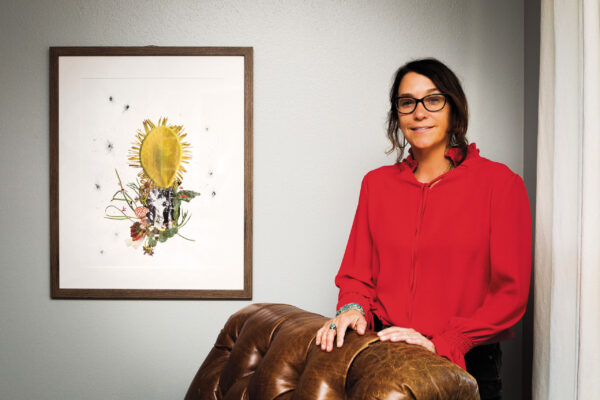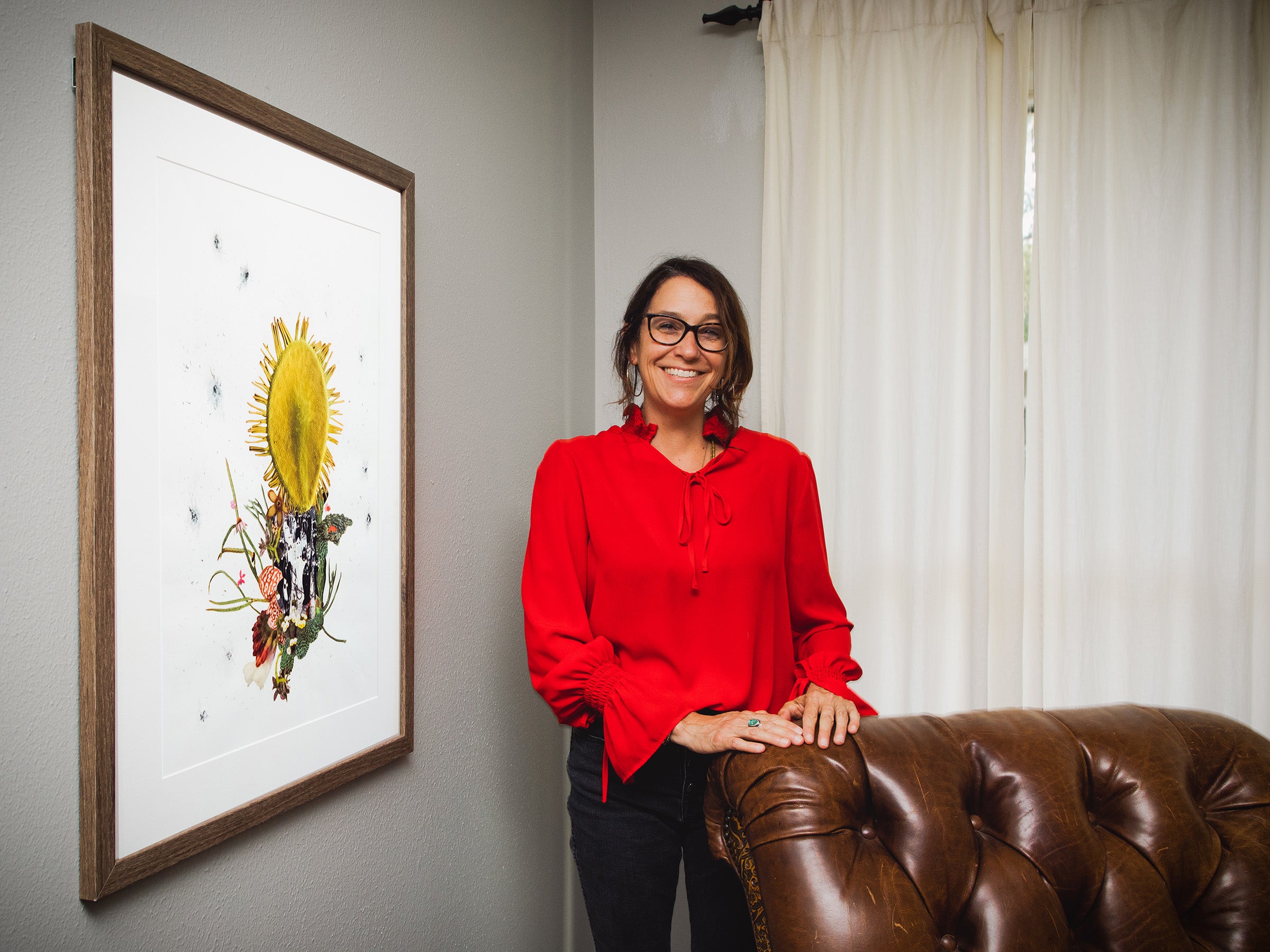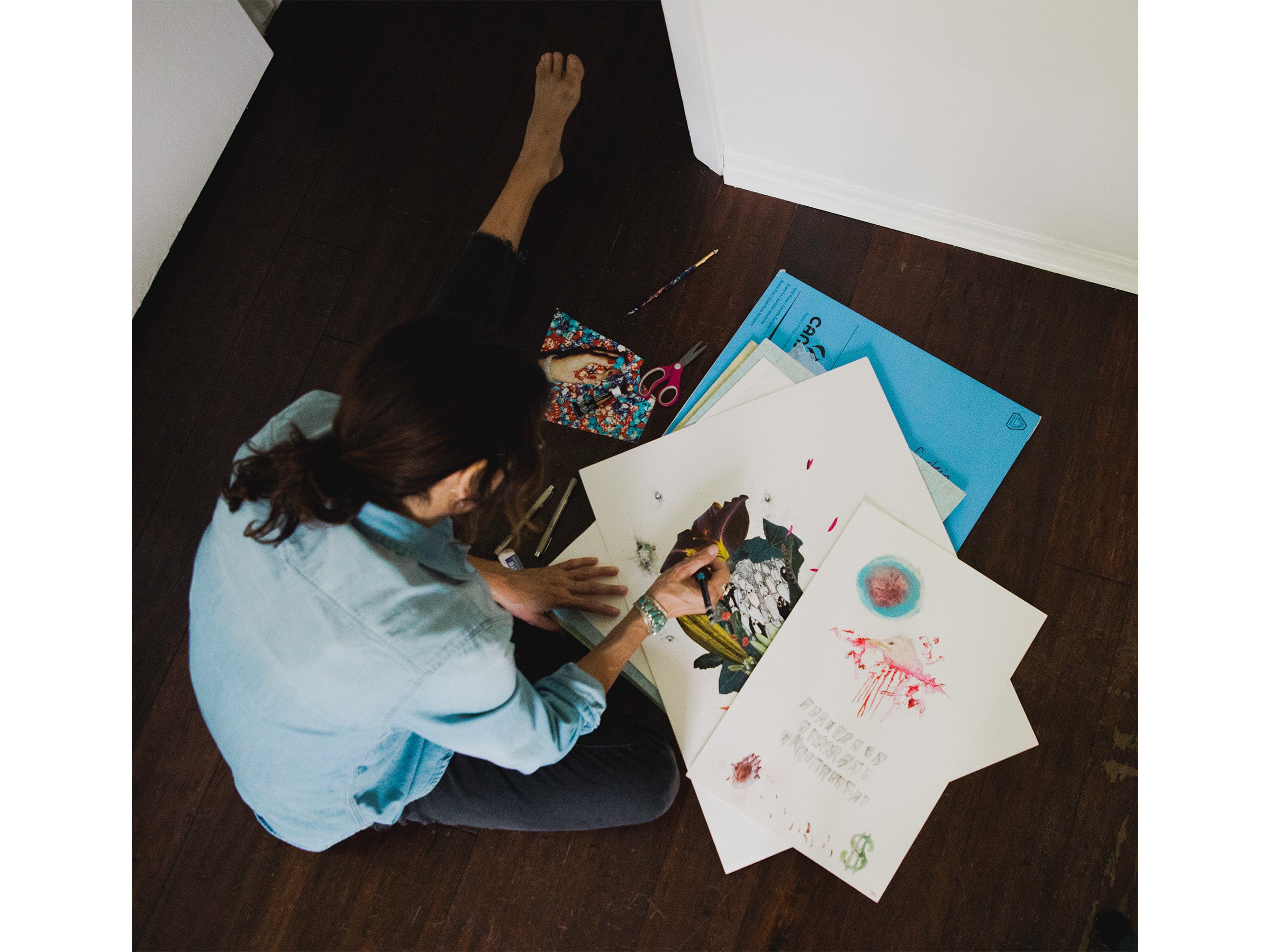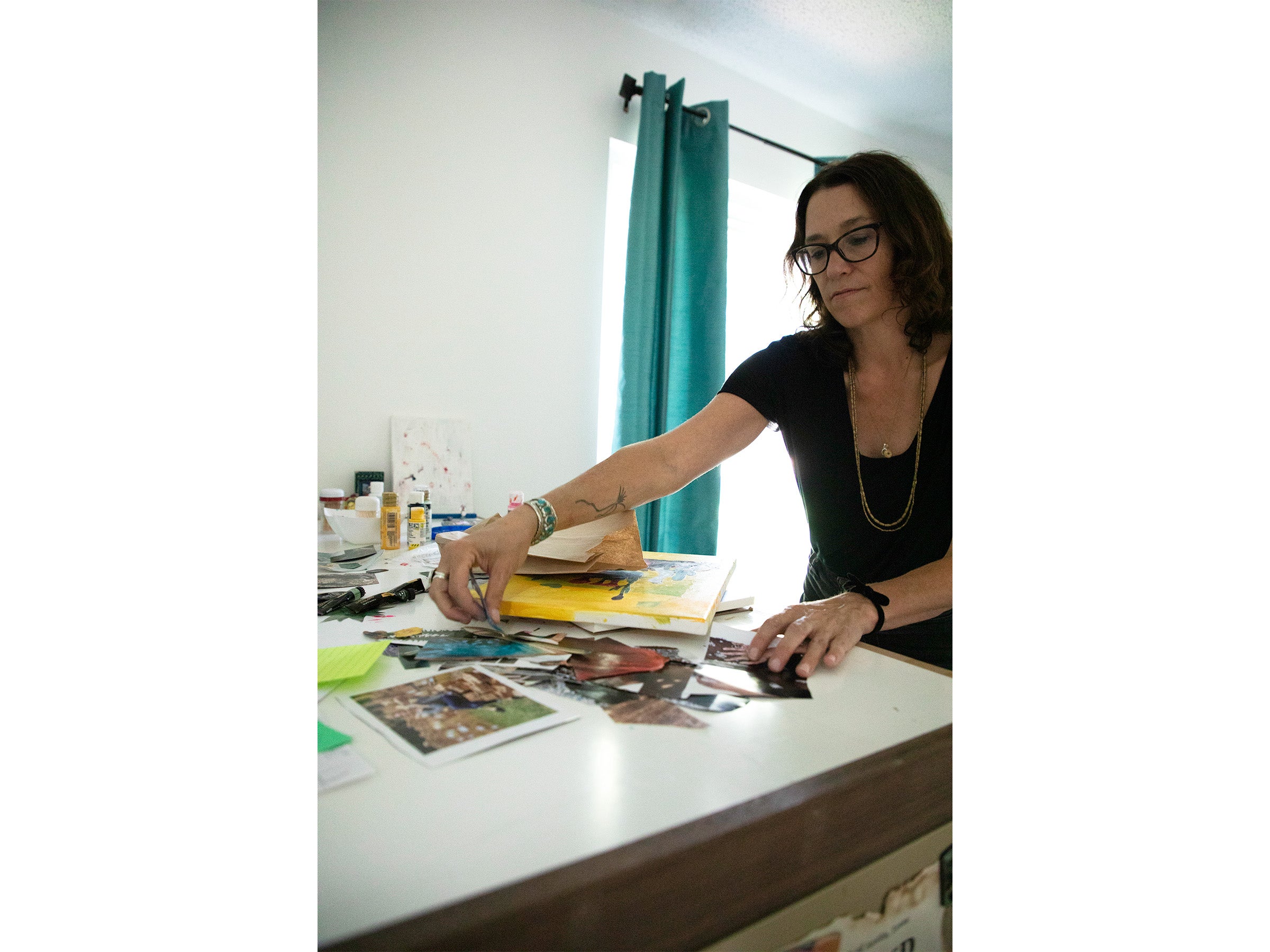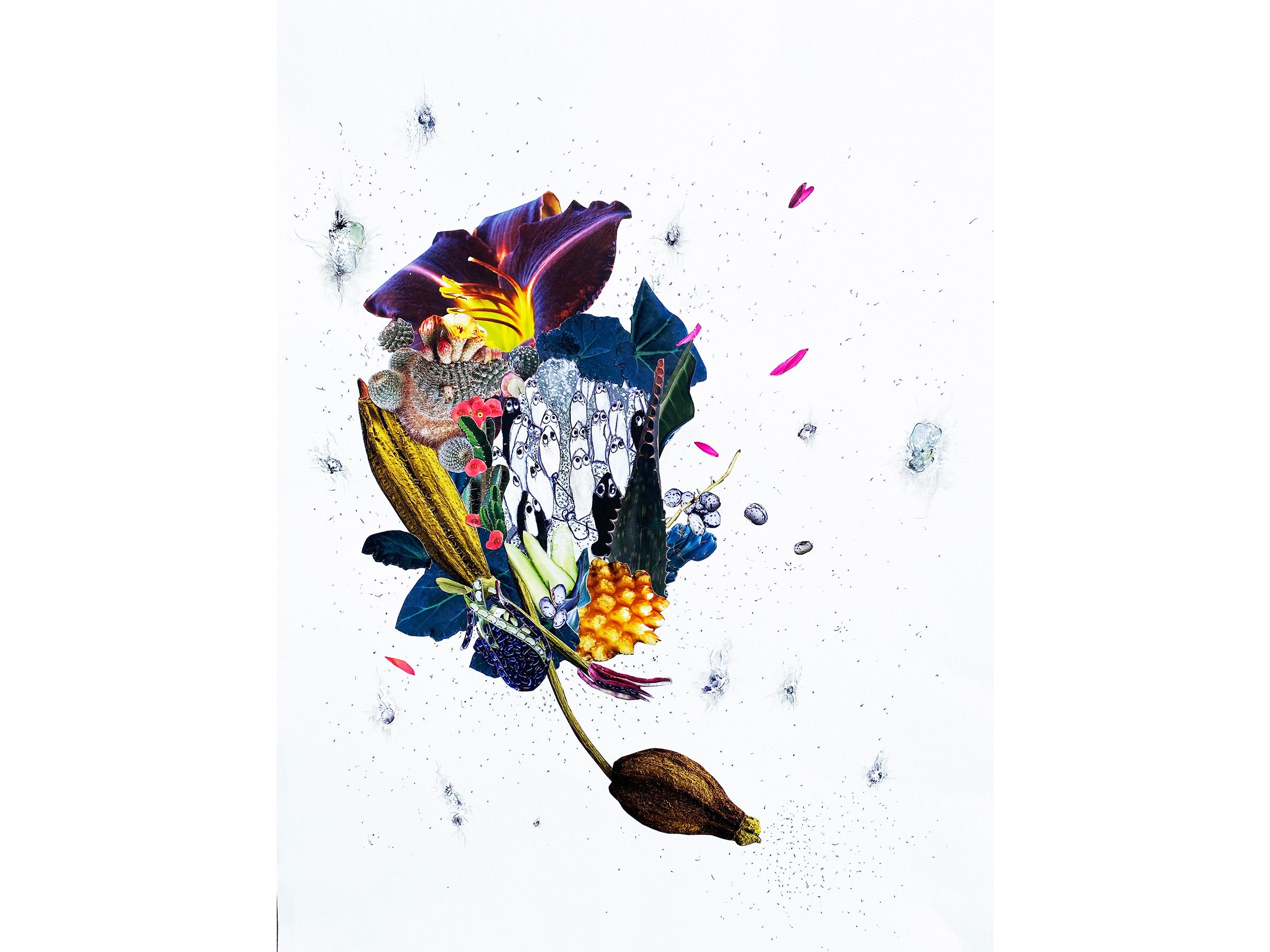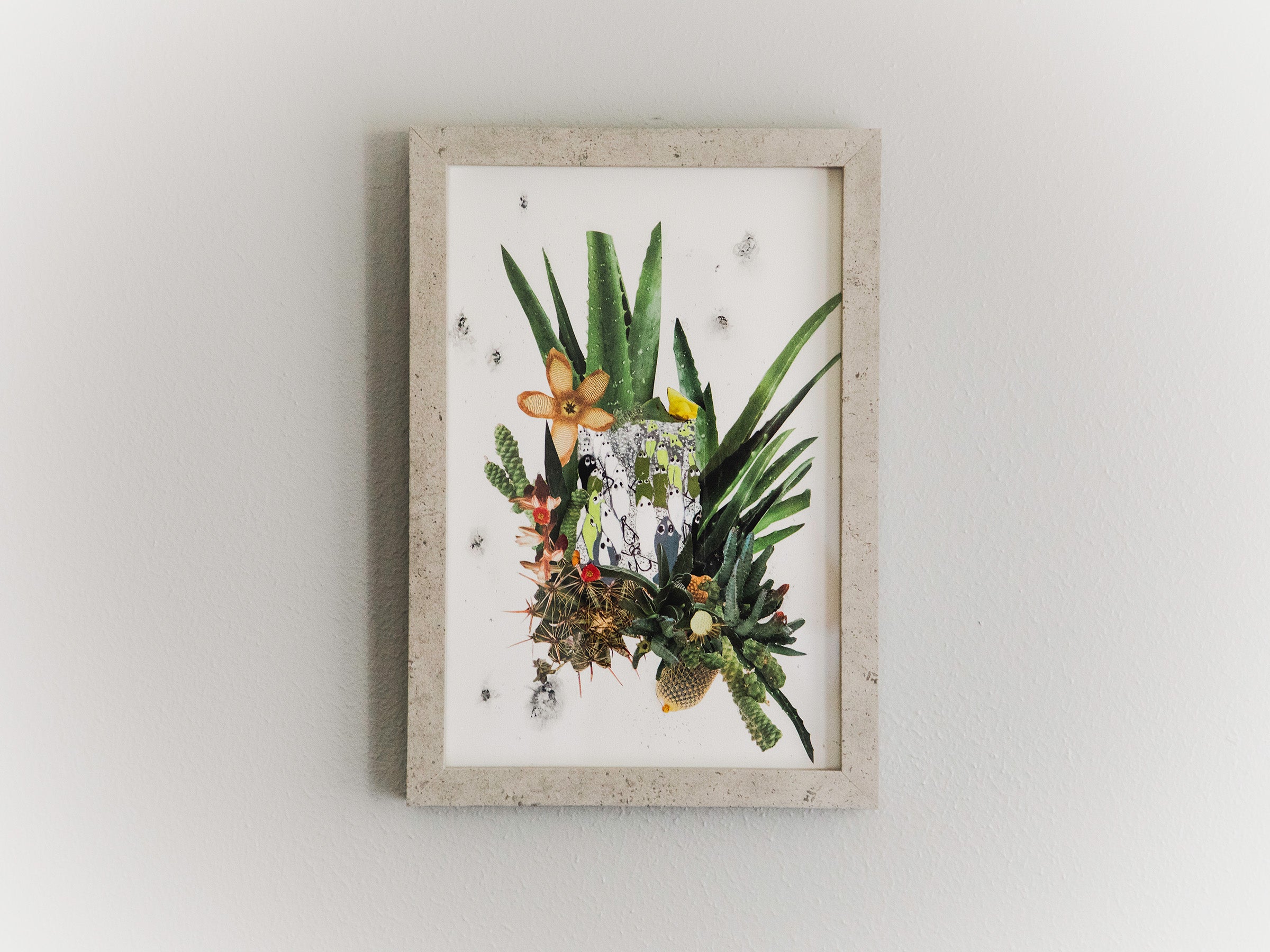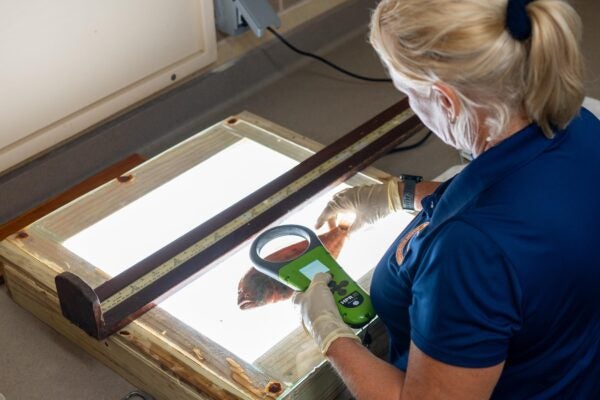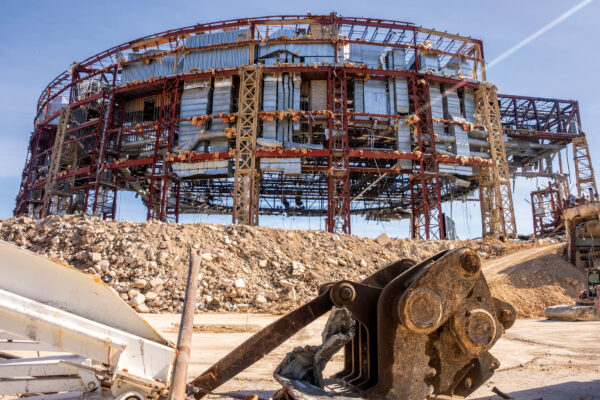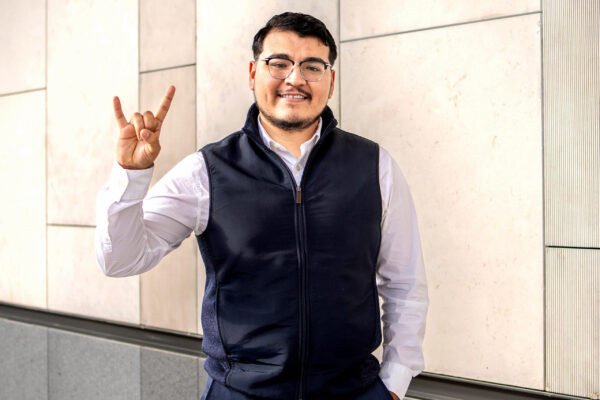Laura Klopfenstein arrives home from campus at 5 p.m. and changes out of her work clothes. She spends quality time with her family, then steps into the artist’s role. Klopfenstein enters her in-home studio and throws on her art smock — a faded, white Williams Sonoma apron detailed with three vertical red stripes and polychromatic paint splatters. She runs between studio and kitchen — preparing dinner for her family one minute and modifying the composition of her latest art piece the next. An occasional food stain intermingles with the paint on her smock. By day, she works with graduate students in the Department of Civil, Architectural and Environmental Engineering as a senior research program coordinator for the food-energy-water-systems nexus. By night, she devotes her attention to her children and compositions of brightly colored collages and paintings, inspired by her work at UT and the world at large.
Klopfenstein is a self-taught artist represented by the Jen Tough Gallery in Santa Fe, New Mexico. Her most recent shows were at the Amarillo Museum of Art in North Texas and The Museum of Contemporary Art in Nashville, Tennessee. Her home base, the Jen Tough Gallery, highlighted her environmental justice series in the book “Wild Lands,” published in 2021. And The Texas Observer featured her “___vs. Women” collage for the July/August 2022 cover.
Texas Connect’s editorial intern, Kiernan McCormick, interviewed Laura Klopfenstein for the following Q&A. Some answers were modified for length and clarity.
We share physical, emotional and spiritual space with the natural world, and we are deeply connected to the earth as a living organism.
How does your role as research program coordinator intersect with your role as an artist?
I grew up outdoorsy and interested in science — especially biology. That led to a deep love for the environment. Today, the students I work with are environmental and water resources engineers. They solve a lot of complex issues using math, science and chemistry. In our collaboration, I bring soft skills to the table and an artistic perspective. I’m a liaison between the science and engineering that happens in the department and people outside, informing the community that we all need to take part in protecting the environment.
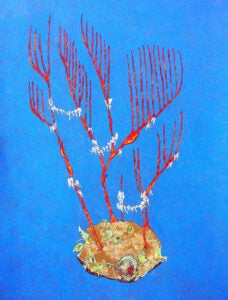
Does the graduate research inform the artwork you create? If so, how?
Definitely. I sometimes say my art is an abstraction of what they’re working on. I read their reports, and I process it as much as I can from a non-engineer point of view, then I spin it around into a visual translation.
For example, some of their research is molecular. That’s hard to translate to the average person. So it takes some back and forth between scientific and creative thoughts. I think about their projects and strategize how to make them visual, while including my sense of humor, artistic sensibilities, and style. I specifically draw ideas from the research done around water, oceans, and climate change and how their lab work speaks to environmental justice.
Can you share a specific study and art piece that go together?
The students focus on shared resources in their analyses of the research. Social justice and environmental justice are huge byproducts of the data. Their abstracts use modeling, chemistry and numerical components to describe the inequalities at play. I’m taking these concepts and putting them into visual language.
Many of my collages use fishing lures, cacti and plants. The elements speak to social justice issues. One example from this series is “Origin.” In this piece the lures represent humankind. They look like little ghost people when grouped together, non-thinking masses with a permanent expression of confusion and apathy, determined to celebrate ignorance and stifle advancement of our society. Layers of flowers, cacti and other plants are added to show our connection to the environment. I often use flora and fauna to reflect on the “lastingness” of the human footprint, and to express how the natural world shares space with the fishing lures (people).
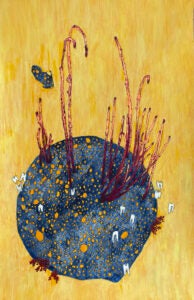
Can you elaborate on the ideas that inspire and inform the fishing lure, ghost people series?
It’s humanity’s connection to the environment. We share physical, emotional and spiritual space with the natural world, and we are deeply connected to the earth as a living organism. These works include symbols of hope and revolution — the singed paint and ink marks imply that a fire has started and the current paradigm could and should go up in a cleansing flame.
Have any UT faculty or staff members influenced your work and journey as an artist?
Yes, a woman named Melissa Miller. She was an art faculty member, and a big-time artist in the early ’90s. I first sought her mentorship when I became a new mom. She was so kind to me, and she understood where I was at in my life. She offered critiques of my early work and gave me ideas. She reassured me and said, “You can be an artist and you can be a mother. All the artist moms in my classes are super focused and hardworking.”
For years those words played in my mind again and again. It took me a long time to admit that I was an artist because I struggled with impostor syndrome. Now I’m cool with it. My own process helps me understand the struggle I see in some of my students. As engineers, they have permission through their education to get out in the world and do some high level work, and it’s a lot of responsibility.
Other people who have influenced my work are the female engineering faculty. I look up to them from a feminist perspective. I see that their challenges are different from their male colleagues — sometimes those observations trickle into my artwork as well.
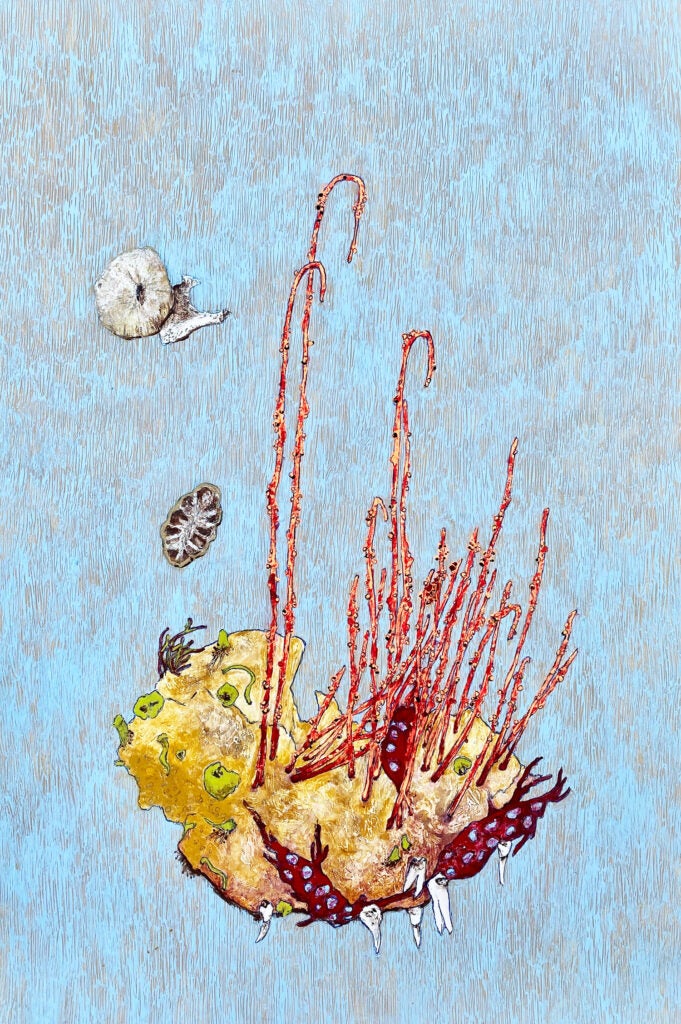
How do you balance your job at UT, your art career and motherhood?
I have to whittle things down in my life and focus on work, art, and then my family and friends. I compartmentalize a lot. I’m not super successful at weaving it all together on a daily basis. I learned to accept that there isn’t much time for reading and watching shows right now. Instead, I work on a new collage in my spare time. I can get a lot done in 20 or 30 minutes; it’s easy for artists to overwork and make really bad decisions. All the pieces and compartments of my life are little blessings in disguise.
Do you have a home studio? What does it look like?
Yes, it’s in the front of my house. It has a nice window. Inside there’s a large flat file cabinet where I store my artwork. The cabinet has big drawers — maybe 3 feet across, like what architect’s use to store blueprints. The top of the cabinet is one of my main workspaces. I have another table for my collages, where I keep works in progress that contain a lot of pieces. It gives me the freedom to start and stop and come back to them when I have time without cleaning up. Then there’s a whole closet full of art supplies and reference books on my floor. There are projects in progress everywhere.
How often do you find time to go there?
I’m in my studio about eight to 10 hours a week. There’s also an administrative component to the art world that’s less romantic — actually it’s quite boring. Artists apply for shows and submit artists’ statements. There’s a tremendous amount of writing involved. I have to be able to talk about my art in an intelligent way, like a sales pitch to the rest of the world.
What is the best part of your job at UT?
Working with students is amazing. I get to watch them grow and evolve. I see them work on their passions and become more comfortable in their own skin. I witness them make cool intellectual connections and make the world a better place. They add to real solutions we need. When I work with them I see UT’s tagline come to life: “What starts here changes the world.” It’s a little cheesy, but it’s true.
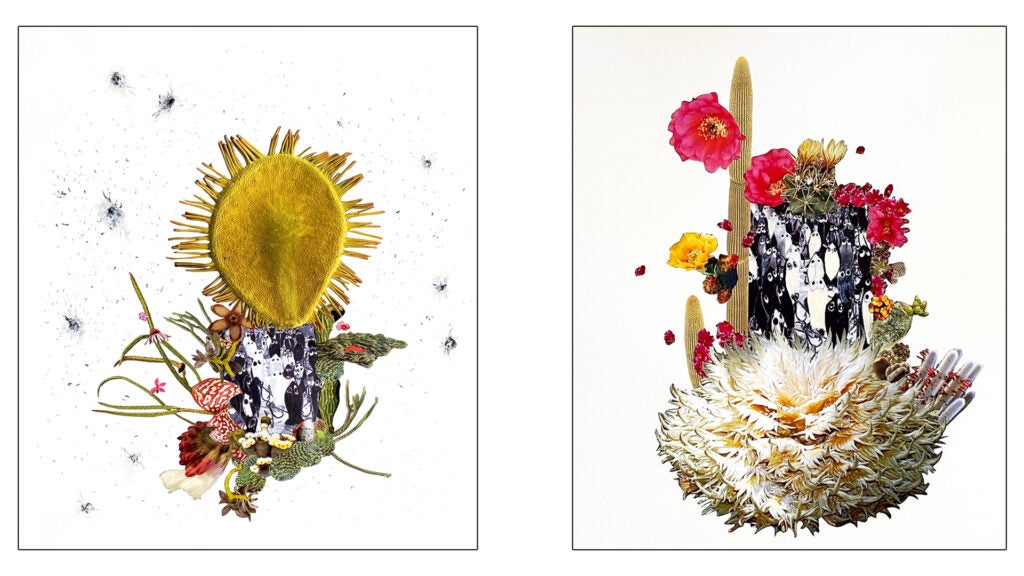
Right: “Origin,” collage and acrylic on paper, 2019
What are some projects the graduate students are currently working on that you’re supporting?
Right now, we’re focused on wastewater treatment, drinking water treatment and low-cost water filtration systems, adaptable for low-income communities. Water remediation takes polluted water and removes the contaminants to create a sustainable, reusable resource. Some students are creating synthetic filtration solutions inspired by naturally occurring membranes. Organic systems found in the natural world are roadmaps for infrastructure development. It’s fascinating.
Other students focus on solutions to eliminate fossil fuels and facilitate energy transition for more resilient infrastructure. For example, when we have all these extreme weather events, the work they do ensures that water treatment plants don’t shut down. A lot of that technology is needed and used in equatorial regions where clean water is lacking.
What about your work as an artist do you find most meaningful?
It’s freedom. There are no rules. I get to make my own decisions, good or bad. I don’t have to answer to anybody, and I get to know different parts of myself. I push and challenge things in ways that I can’t necessarily do in a job. I explore concepts as a fun and intellectual challenge. Adding a visual component to science and engineering is like putting together a puzzle. I have to move back and forth between the two parts of my mind. There’s something about using your brain and your hands to craft something original that’s very human.
Do you think the relationship between the left and right side of the brain is something more people can harness?
I think it’s achievable and it’s where we all need to be going. We have to break those boundaries. We have to listen to and trust ourselves — to appreciate ideas that come to us. Using both sides of the brain, opens up new ways of thinking about the world and different topics. We can find solutions by having conversations with people who think about things differently, too. I certainly benefit from being around people that don’t see systems through an engineer’s lens. It challenges me on a whole new level and makes me appreciate the work people do. Scientific discovery works in tandem with artistic discovery. When an artist or engineer advances their practice, they break into moments of creative inspiration. Creativity always invites new ways of approaching a problem, equation or composition.
What was it like to see your art on the cover of The Texas Observer’s July/August 2022 issue?
It’s a dream come true. I had a lifelong ambition to do a magazine cover, especially on a topic that I’m very passionate about. The cover focuses on the environment and justice for women’s rights. It was so intense because the release was right around the time the Supreme Court published the official decision on Roe v. Wade. So the release was bittersweet. That was a tough day for so many of us. In hindsight, my art on the cover feels like a love letter to anyone with a uterus.
Are you currently working on a new piece or series?
I’m working on more of my fishing lure ghost people series.
Do you have any shows coming up in Austin?
I am applying to several shows right now. My most recent Texas-based show was at Artexpo Dallas from Sept. 16-18. Outside of Texas, several pieces were recently accepted to Collar Works Gallery Flat Files for 2022-2023 at their nonprofit gallery space in Troy, New York. And I’m waiting to hear back from many others.

